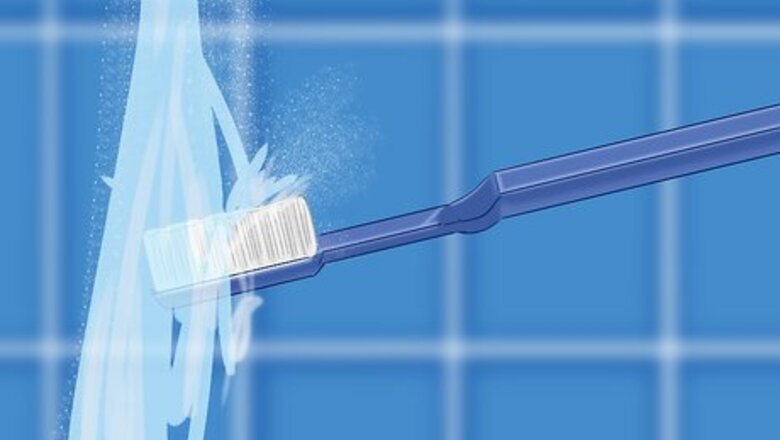
views
toothbrush may poke your gums here and there, as bristles may have been sharpened during the factory production. You should take care of your brush in the same way that you take care of any of your other accessories. Only a clean brush can promote good oral hygiene, as stiff/unclean brushes store bacteria and can aggravate oral problems. Learning how to soften and clean your toothbrush, as well as knowing when to replace it, can help you take better care of your teeth.
Softening Your Toothbrush
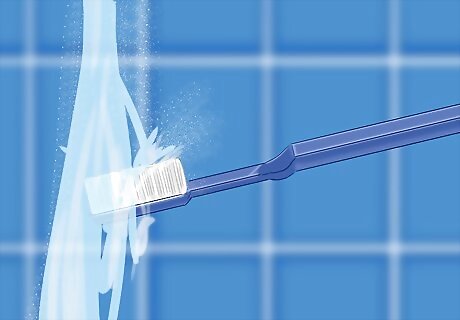
Run it under hot water. Holding your toothbrush under hot water is one of the most effective ways to soften your bristles. As the water heats the bristles and gets absorbed in the fibers, it will soften them and make them more pliable. Hold the handle of the toothbrush so you won't burn yourself. Let your tap water get hot, then put the bristles under the tap. You can also try soaking your toothbrush in a glass of hot water, but be aware that the water will cool down fairly quickly. It may be less effective unless you replenish the hot water periodically. Be aware that while hot water will soften your bristles, it could render your toothbrush less effective. Hot water is also more likely to pick up metals and other harmful chemicals from your water tank or municipal pipes.
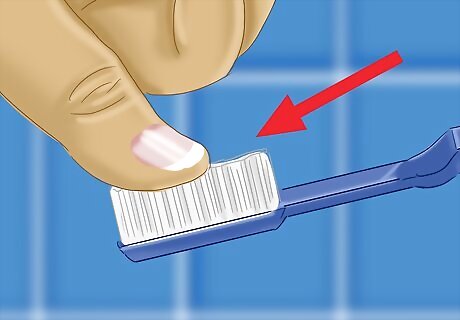
Massage the bristles. Some people find that massaging the bristles of a brush can make them softer and more broken in. This is commonly done to soften the bristles on a hair brush, but can easily be applied to a toothbrush. Hold the handle of the brush in one hand and rub the bristles against a clean finger or the palm of your other hand. Apply pressure with your finger or palm against the bristles in one direction while gently pushing the brush in the opposite direction with your other hand. Switch directions. If you were previously pushing up with your palm and down with the brush, start pushing down with your palm and up with the brush. Work the bristles side to side against your palm and move it with a circular motion. Try to massage the bristles equally in both directions. Aim to massage the bristles about 20 times. This should adequately soften the bristles on its own, but you can also run the toothbrush under hot water first to further break it in.
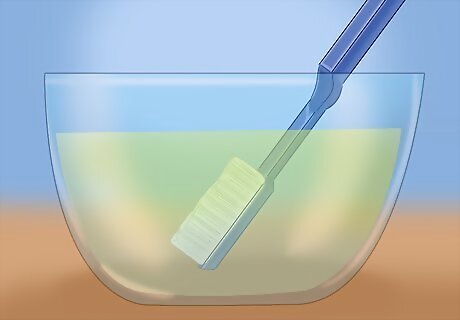
Try soaking it in vinegar. A common trick for softening paintbrushes can also be applied to softening a stiff-bristled toothbrush. Warm vinegar is an excellent way to remove dried-on paint and soften the nylon bristles of a hand-held paintbrush, so it's no surprise that some people might try this trick with a stiff toothbrush as well. Pour enough vinegar into a glass or mug so that the bristles will be completely submerged. Warm the glass up in a microwave, ensuring that you use a microwave-safe container. It doesn't need to be boiling, just warm to the touch — try checking it after 20 to 30 seconds. Submerge your toothbrush upside down in the glass of warm vinegar. Make sure the bristles are completely covered. Let it soak for about 30 minutes. When you're finished, rinse the toothbrush under hot water to remove any excess vinegar. You may also want to try massaging the bristles for increased effectiveness. Vinegar can also have a slight antibacterial effect, which is good for any plaque left in the tip of the brush. If the bristles still taste like vinegar, try soaking them overnight in a cup of mouthwash. If you use mouthwash regularly, you won't mind the minty taste on your toothbrush.
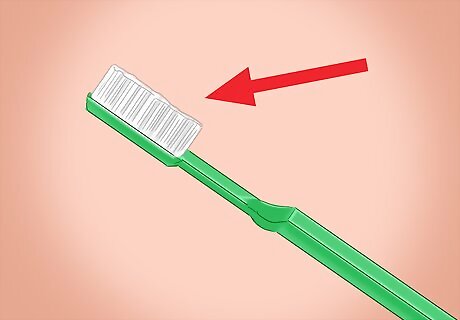
Buy a softer toothbrush. Toothbrushes are generally available in a number of grades, ranging from ultra-soft, soft, medium, and hard. Though ultimately a matter of preference, most dentists recommend using a soft or ultra-soft brush for both adults and children. Stiff bristles can be more effective at removing plaque and scrubbing out stains, but over time those hard bristles can damage your teeth and gums and you may develop problems such as enamel loss, dentin erosion or gum recession. Try a soft or ultra-soft brush for a more gentle experience on your teeth enamel and gums. Check your toothbrush's packaging for the American Dental Association's (ADA) Seal of Acceptance. This indicates that the toothbrush meets the ADA's guidelines of having safe bristles that aren't sharp or jagged and won't fall out with regular use.
Caring For Your Toothbrush
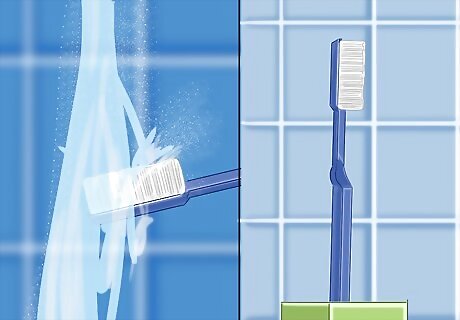
Rinse and store your brush after use. If you put your toothbrush away immediately after using it, you run the risk of your toothbrush harboring bacteria, mold, or fungus. Wet things put away in dark places tend to be breeding grounds for these microorganisms, and if there is any residual toothpaste or food particles on your bristles there's an even greater chance that something will grow. Thoroughly rinse your bristles under tap water after brushing. If you're concerned about your toothbrush harboring bacteria, you may want to use hot water to clean it more effectively. Store your toothbrush in an upright position to let the water drip out of the bristles. Allow the brush to air dry before you use it again — keep it in an open space, but not too close to the toilet or shower. Do not cover a toothbrush or store it in a closed container. This is more likely to encourage microorganism growth than an open-air environment.
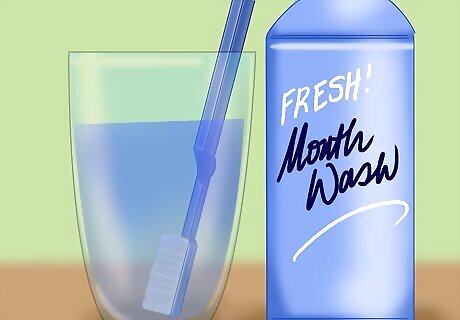
Give your toothbrush a deep clean. Because bacteria naturally coats the inside of your mouth, you may want to periodically give your toothbrush a deep clean. This doesn't need to be done very often, but it's important to do any time you recover from an illness, especially if you suffer from an immune disorder. In most cases, deep cleaning once every month or so is probably sufficient. Soak your toothbrush in antiseptic/antibacterial mouthwash. Simply fill a small cup with enough mouthwash to submerge the bristles, and leave your toothbrush soaking in it upside down. Try putting your toothbrush through the dishwasher. The extreme heat and soap that run through your dishwasher will leave your toothbrush clean and free of bacteria, but it may melt your handle if you do this too often. Make sure you rinse the bristles to remove any soap residue. Some people soak their toothbrush in vinegar once a week to kill bacteria. Others periodically soak toothbrushes in a 3% solution of hydrogen peroxide, or by mixing two teaspoons of baking soda into one cup of warm water. Clean and sterilize your toothbrush after use by placing it within a UV disinfection unit.
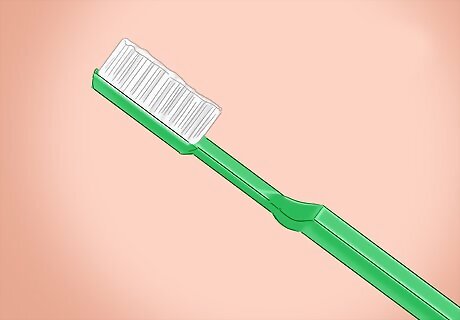
Replace your toothbrush regularly. The ADA recommends replacing your toothbrush at least every three to four months; however, you may need to replace the toothbrush sooner, as the bristles will become frayed over time. Stop using a toothbrush immediately if it hurts your teeth or gums, or if the bristles have become mangled and damaged. Discard old toothbrushes in the trash and buy a brand new replacement. You can buy a toothbrush at virtually any pharmacy, corner store, or general dry goods retailer. Look for the ADA Seal of Acceptance on any new toothbrush that you purchase.




















Comments
0 comment